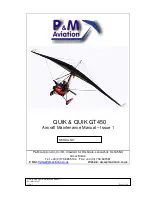
The cabin altitude is indicated by a single pointer
and a circular scale on the outer edge with
CABIN ALT markings from 0 to 50,000 feet.
The cabin differential pressure is indicated
by a circular scale on the inner portion of the
indicator and a single pointer. The scale rep-
resents differential pressure from 0 to 10 psi.
Earlier airplanes do not have a cabin differ-
ential pressure scale, and the cabin altimeter
only indicates to 45,000 feet.
Cabin Vertical Speed Indicator
The cabin vertical speed indicator (Figure
12A-11) indicates a cabin climb or descent
from 0 to 2,000 feet per minute.
OPERATION
Normal System Operation
Before Takeoff
During ground operation, the AIR BLEED
switches are not turned on while the Freon
system is being used. If the bleed air is turned
on, then engine power must be limited to 70%
rpm or less because possible damage to the
bleed-air conditioning system may result.
Before takeoff, the desired flight altitude and
rate of climb should be selected, the AIR
BLEED switches turned on, and normal cabin
airflow selected.
Flight Operation
Automatic
At liftoff, the left squat switch or the squat
switch relay box on SNs 24-210 and subse-
quent and 25-046 and subsequent (except
-061), permits either the outflow or cabin
safety valve, as appropriate, to close and pres-
surization to begin. The cabin altitude begins
to climb at the rate selected on the controller.
On airplanes SNs 24-185, -188, -190, and sub-
sequent, and 25-027, -029, and subsequent, a
timer activates a secondary down solenoid for
23 to 50 seconds after takeoff. This allows
the cabin to pressurize sooner by closing the
outflow valve more quickly.
Manual
In case of a malfunction of the cabin altitude
controller or airplane electrical power fail-
ure, cabin altitude can be manually controlled
by selecting MAN position. The MAN posi-
tion removes the cabin altitude controller, rate
sensor, and amplifier from the system. With
the cabin altitude emergency valve (cherry
picker) in the UP ALT position, the reference
chamber pressure bleeds to static.
This action opens the outflow path and allows
the cabin to depressurize. Setting the cherry
picker to DN ALT position allows cabin pres-
sure to be admitted to the reference chamber.
The closed outflow path under the main di-
aphragm allows the cabin to pressurize. In
manual mode, the cabin altitude must be mon-
itored much more closely than in automatic
mode, and the outflow valve position must be
adjusted frequently during climbs, descents,
and when making power adjustments. On SNs
23-003 through 23-029, with 28 VDC not
available, cabin altitude cannot be adjusted.
Descent
When descending for a landing, the field baro-
metric pressure can be set in the cabin con-
troller subdial by pulling out the right knob and
rotating it to the desired setting. The knob
should return to its normal spring-loaded po-
sition with the field elevation set on the outer
scale. The barometric pressure on the subdial
can be left at 29.92 unless a radical baromet-
ric pressure exists at destination, at which
point the subdial should be set to that value.
If the aircraft descends rapidly, it is possible
for the cabin pressure to become lower than
the outside pressure. If a negative differential
develops, the outflow and/or cabin safety valve
opens to relieve the negative pressure.
Should the selected altitude require a cabin dif-
ferential pressure greater than the maximum
differential, the outflow valve overrides the
controller and maintains the differential within
prescribed limits.
12A-11
FOR TRAINING PURPOSES ONLY
LEARJET 20 SERIES PILOT TRAINING MANUAL
FlightSafety
international
















































